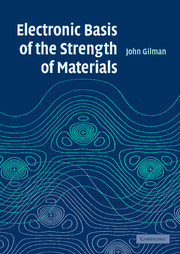Book contents
- Frontmatter
- Contents
- Preface
- Section I Introduction
- Section II Elements of solid mechanics
- Section III Elements of electron mechanics
- 5 Properties of electrons
- 6 Quantum states
- 7 Periodic patterns of electrons
- 8 Heisenberg's Principle
- Section IV Elastic stiffness
- Section V Plastic strength
- Section VI Fracture resistance
- Index
- References
6 - Quantum states
Published online by Cambridge University Press: 14 August 2009
- Frontmatter
- Contents
- Preface
- Section I Introduction
- Section II Elements of solid mechanics
- Section III Elements of electron mechanics
- 5 Properties of electrons
- 6 Quantum states
- 7 Periodic patterns of electrons
- 8 Heisenberg's Principle
- Section IV Elastic stiffness
- Section V Plastic strength
- Section VI Fracture resistance
- Index
- References
Summary
The most simple atom is hydrogen consisting of a positive proton at the center, and one negative electron swarming around it. While the proton is concentrated at the center, the electron swarms in a pattern that depends on its total energy, and its angular momentum. In the lowest energy state of the hydrogen atom, the shape of the pattern is simply a sphere, but in higher energy states the pattern resembles a dumbbell, or a three-dimensional cloverleaf. For atoms with more than one electron, each electron has its own pattern, or state.
The fundamental postulate that determines the behavior of atomic electrons is that of de Broglie (1924). This states that an electron of mass, m, and velocity, υ, and therefore with momentum, p = mυ, has a wavelength, λ, associated with it that is given by λ = h/p, where h is Planck's constant. If T = mυ2 / 2 is the kinetic energy, then the expression for the wavelength can also be written λ = hm / 2T, so the wavelength depends inversely on the kinetic energy. Thus short wavelengths mean high energies and vice versa. Initially, this seemed to be a rather arbitrary proposal, but it has been verified by many, and differing, experiments, and has led to vast numbers of quantitatively precise interpretations of phenomena.
- Type
- Chapter
- Information
- Electronic Basis of the Strength of Materials , pp. 37 - 51Publisher: Cambridge University PressPrint publication year: 2003



